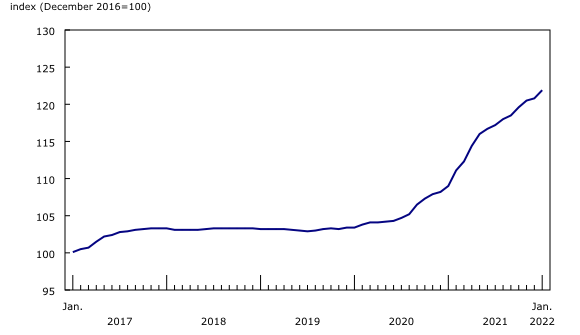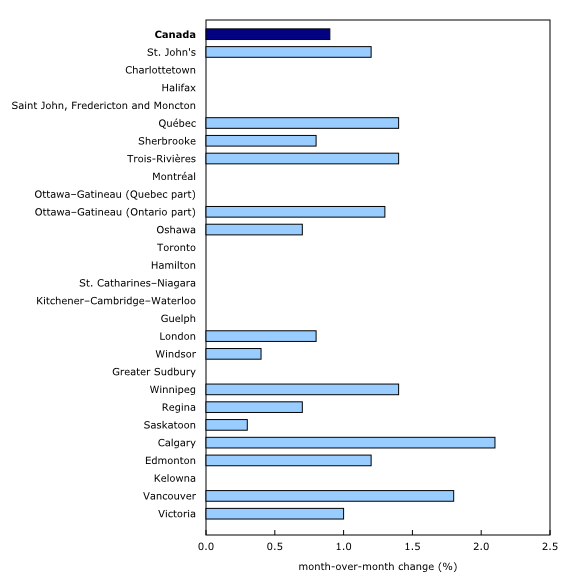New Housing Price Index, January 2022
Archived Content
Information identified as archived is provided for reference, research or recordkeeping purposes. It is not subject to the Government of Canada Web Standards and has not been altered or updated since it was archived. Please "contact us" to request a format other than those available.
Released: 2022-02-18
January 2022
0.9% 
(monthly change)
January 2022
1.2% 
(monthly change)
January 2022
0.0%
(monthly change)
January 2022
0.0%
(monthly change)
January 2022
0.0%
(monthly change)
January 2022
0.2% 
(monthly change)
January 2022
0.3% 
(monthly change)
January 2022
1.4% 
(monthly change)
January 2022
0.5% 
(monthly change)
January 2022
1.7% 
(monthly change)
January 2022
1.7% 
(monthly change)
National Overview
In January 2022, new home prices for Canada grew by 0.9% compared with December 2021, slightly up after the market had a brief slowdown in December. Prices were up in 15 of the 27 census metropolitan areas (CMAs) surveyed, and unchanged in 12.
Persistent high construction costs and supply challenges
The growth was principally attributed to higher construction costs as reported by the contractors. The Industrial Product Price Index recorded the strongest-ever monthly increase for softwood lumber prices (+32.8%) in December 2021.
In its fourth quarter Housing Market Index Survey, the Canadian Home Builders' Association found that elevated costs of lumber and other construction materials increased the average construction cost by 13% in the fourth quarter of 2021 compared with the previous quarter. It was also reported that supply chain issues, labour shortages, and low supply of developed lots in some areas were affecting the housing industry. Survey respondents identified that plumbing materials as well as plumbing fixtures were the most impacted by the supply chain issues.
Low supply mostly driving monthly home price increases
In January 2022, Calgary (+2.1%) recorded the highest monthly increase in new home prices among the 27 CMAs surveyed. According to the Calgary Real Estate Board, inventory levels were at lows not seen since 2006. Compared with other hot real estate markets in Canada, home prices in Calgary continued to be more affordable and attracted buyers from other provinces. Higher demand for housing in Alberta was bolstered by new migrants to the province. In the third quarter of 2021, the net number of interprovincial migrants and immigrants (16,406) reached its highest level since the second quarter of 2015.
Compared with December 2021, prices for new homes in Vancouver rose 1.8% in January 2022, the fastest monthly price acceleration since May 2017. The Real Estate Board of Greater Vancouver noted that while home sales in January 2022 were down the record-setting pace a year earlier, low supply continued to push home prices into record highs.
Higher sales levels, higher prices trending in census metropolitan areas across Canada
Nationally, new home prices rose 11.8% on a year-over-year basis in January 2022.
The Kitchener–Cambridge–Waterloo CMA (+27.0%) recorded the greatest increase in new home prices year-over-over for January 2022, followed by Winnipeg (+22.5%) and Windsor (+21.0%). According to the Canadian Real Estate Association, these CMAs have each seen large growth in sales levels in the past year.
Note to readers
In addition to this monthly release, the New Housing Price Index (NHPI) has also been integrated into the Residential Property Price Index (RPPI) (see Methodology of the Residential Property Price Index (RPPI)). The RPPI is a quarterly series that measures changes over time in the prices of residential properties for Montréal, Ottawa, Toronto, Calgary, Vancouver and Victoria. An aggregate for these six census metropolitan areas (CMAs) is also available. The RPPI provides a price index for all components of the housing real estate market—new and resale—in addition to a breakdown between houses and condominium apartments.
The NHPI measures changes over time in the selling prices of new residential houses. The prices are those agreed upon between the contractor and the buyer at the time the contract is signed. The detailed specifications for each new house remain the same between two consecutive periods.
The prices collected from builders and included in the index are market selling prices less value-added taxes, such as the federal goods and services tax and the provincial harmonized sales tax.
The survey covers the following dwelling types: new single homes, semi-detached homes and townhomes (row or garden homes). The index is available at the national and provincial levels and for 27 CMAs.
The index is not subject to revision and is not seasonally adjusted.
Products
The article "The resilience and strength of the new housing market during the pandemic" examines the changes in new home prices in Canada for the 27 surveyed CMAs captured in the NHPI. It compares the ranking of cities based on home prices six months into the pandemic (August 2020 compared with February 2020).
The article "Price trends and outlook in key Canadian housing markets" looks at where the housing market was at the onset of the COVID-19 pandemic, sheds light on what has happened since then and explores the challenges of the Canadian market going forward.
The infographic "The impact of COVID-19 on Key Housing Markets," part of the series Statistics Canada—Infographics (11-627-M), is available. It provides an outlook on the housing market before, during and after the onset of the COVID-19 pandemic.
The "New Housing Price Index: Interactive Dashboard," which allows users to visualize statistics on new housing prices, is available.
The "Housing Market Indicators" dashboard, which provides access to key housing market indicators for Canada, by province and by CMA, is also available.
For more information on the topic of housing, visit the Housing statistics portal.
The video "Producer price indexes" is available on the Statistics Canada Training Institute webpage. It provides an introduction to Statistics Canada's Producer Price Indexes—what they are, how they are compiled, and what they are used for.
Statistics Canada launched the Producer Price Indexes Portal as part of a suite of portals for prices and price indexes. It provides users with a single point of access to a wide variety of statistics and measures related to producer prices.
Next release
The New Housing Price Index for February 2022 will be released on March 18, 2022.
Contact information
For more information, or to enquire about the concepts, methods or data quality of this release, contact us (toll-free 1-800-263-1136; 514-283-8300; infostats@statcan.gc.ca) or Media Relations (statcan.mediahotline-ligneinfomedias.statcan@statcan.gc.ca).
- Date modified:



